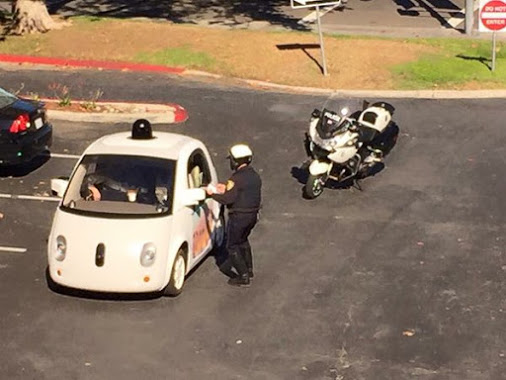An autonomous Google car was pulled over by police for driving too slowly in Mountain View, California on Thursday.

According to the Mountain View Police Department (MVPD), an officer noticed a car driving 24mph in a 35mph zone, slowing down regular traffic on El Camino Real near Rengstorff Avenue – an intersection approximately 2.3 miles from Google’s headquarters.
The MVPD wrote in a statement:
The car was traveling at 24 mph in a 35 mph zone. As the officer approached the slow moving car he realized it was a Google Autonomous Vehicle. The officer stopped the car and made contact with the operators to learn more about how the car was choosing speeds along certain roadways and to educate the operators about impeding traffic per 22400(a) of the California Vehicle Code. The Google self-driving cars operate under the Neighborhood Electric Vehicle Definition per 385.5 of the California Vehicle Code and can only be operated on roadways with speed limits at or under 35 mph. In this case, it was lawful for the car to be traveling on the street as El Camino Real is rated at 35 mph.
The Mountain View Police Department meets regularly with Google to ensure that their vehicles operate safely in our community.
While no action was taken by the police, it does pose the question: Are Google cars, in their current forms, too cautious? The company has capped their self-driving cars at 25mph for safety reasons.
“We want them to feel friendly and approachable, rather than zooming scarily through neighborhood streets,” Google posted. “We're proud to say we've never been ticketed.”
However, Google is working on making its autonomous cars more humanistic, following complaints that they were too polite. The cars are programmed to obey the rules of the road, but this may cause issues when the vehicles are sharing the road with human drivers who are not following the laws.
Researchers have recognized that their biggest challenge is getting autonomous cars to work well with human drivers. More recently, this issue was illustrated in an accident report published by the California DMV describing a Google self-driving car as “an abundance of caution” at a pedestrian crossing as the car braked and another vehicle driven by a human rear-ended it. Both cars sustained damage.
But, maybe such caution is for the better. Statistics show that 90 percent of all car accidents are caused by human error. Experts believe self-driving cars will drastically reduce the number of accidents on the road. So, drive on, you cautious Google car, you.
Source: Ars Technica
Advertisement
Learn more about Electronic Products Magazine





